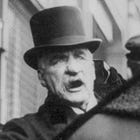Banking and Currency and the Money Trust by Charles A. Lindbergh exposes the structural mechanics and political manipulations behind early twentieth-century American finance. Written in 1913 by a sitting Congressman and a leading Progressive critic of Wall Street, the book unpacks the convergence of private credit power, speculative manipulation, and legislative complicity that shaped the United States’ monetary landscape. Lindbergh positions his analysis within the fight against the so-called “Money Trust” — the concentration of financial authority among a few powerful banking houses — and advances a concrete plan for monetary reform that transfers control of credit from financiers to the people themselves.
The Political Genesis of the Money Question
Lindbergh writes as a legislator deeply enmeshed in the congressional struggle over currency reform. His personal involvement in the “Money Trust Investigation” forms the experiential foundation of his argument. The opening chapters situate his critique in the Progressive Era battle against entrenched privilege. He recounts attempts to unseat Speaker Joseph Cannon, oppose the Taft administration’s reciprocity measures, and resist Woodrow Wilson’s alignment with Allied finance during the early years of World War I. From this perspective, the book becomes both a historical document and a polemic—an insider’s record of the alliance between Wall Street’s speculative interests and national politics.
The Economic Mechanism of Manipulation
Lindbergh defines the “Money Trust” as a man-made power that regulates credit and currency for private advantage. The book outlines how, despite relatively stable supply and demand for goods, market prices fluctuate several times a day, revealing an artificial system controlled by “manipulators” rather than natural conditions. The core of this argument rests on data. By 1912, 28,995 banks operated in the United States, holding over seventeen billion dollars in individual deposits while costing the public more than a billion dollars a year to maintain. These banks, he asserts, generate profit through a process of pyramided credit—expanding loans twenty-four times beyond their actual cash base and diverting the resulting profits upward through interest, dividends, and speculative gains.
Structure and Hierarchy of Banking Power
The book dissects the legal stratification of the banking system into three classes: non-reserve, reserve, and central reserve banks located in New York, Chicago, and St. Louis. Lindbergh traces how the statutory reserve requirement, designed for stability, instead siphons liquidity from Main Street. Non-reserve banks must hold fifteen percent reserves, but are permitted to deposit three-fifths of these in reserve city banks, which in turn deposit half of their own reserves in central reserve cities. The cascade concentrates control of the nation’s money supply within a few institutions. In 1912, six New York banks—the First National, Chase National, Hanover National, National Bank of Commerce, National City, and National Park—held over $839 million in deposits against only $73 million in capital, an eleven-fold leverage that made them, in Lindbergh’s phrase, the “nests from which the Wall Streeters gather the people’s deposits.”
The Political Economy of Credit
Lindbergh’s central claim is that the people supply both the funds and the productive energy that support credit, yet bankers monopolize its use. The depositor receives minimal interest on savings, while the same funds, multiplied through book credits, sustain a vast speculative structure of stocks and bonds approaching fifty billion dollars. Against this figure, the total cash in reporting banks in 1912 stood at just under $1.6 billion. The result is a financial superstructure where dividends and compounded interest perpetually drain value from labor and production into the hands of those who control the circulation of credit.
Legislative Capture and the Money Trust Investigation
The book narrates how Lindbergh’s resolution to investigate the Money Trust was initially buried through congressional procedure. Committees packed with bankers and their attorneys replaced independent inquiry with managed exposure. He describes secret caucuses, manipulated press coverage, and the selection of a Wall Street lawyer to direct the official investigation — all orchestrated to protect financial interests. Through this narrative, Lindbergh exposes the integration of economic and political machinery: banks finance industry, industry finances parties, and parties legislate for the banks.
The Social Consequences of Financial Centralization
Beyond structural analysis, Lindbergh presents the human dimension of monetary exploitation. He observes that while America’s natural resources — its rivers, plains, and minerals — constitute a divine abundance, the people labor under perpetual debt. The energy of millions of workers, farmers, and producers becomes collateral for speculative gain. He argues that the system taxes “our life necessities more than all other things combined,” reducing the worker’s share of productivity even as industrial efficiency multiplies output. The book connects this economic imbalance to social unrest and to the erosion of civic independence.
The False Sanctity of Gold and the Illusion of Capital
In a section addressed “To the Joker,” Lindbergh personifies gold as a deceitful idol that blinds its worshippers. The symbol of wealth, he contends, masks the real process by which energy and production are transformed into instruments of debt. Gold, in his argument, is not wealth but a medium of control—an emblem of the human tendency to mistake representation for substance. This reflection anticipates later populist critiques of the gold standard and foreshadows twentieth-century debates over fiat currency and public credit.
Reform Through Public Control of Credit
Lindbergh’s proposed remedy rejects both the existing banking hierarchy and piecemeal regulation. He envisions a national credit system under public ownership, where the power to issue and manage currency belongs to the people through their government rather than to private corporations. Such reform, he claims, would transform the banker from a master of commerce into its servant. The aim is not the destruction of banking as an institution but the restoration of its public function: to serve exchange rather than to govern it.

The Great Conspiracy of The House of Morgan Exposed Explainer
The Broader Program: Industrial and Political Relations
Banking and Currency and the Money Trust form the first part of a planned trilogy. The second volume, to address industrial relations, and the third, political relations, would extend the same logic of democratization to labor and governance. Lindbergh interprets economic reform as inseparable from political reform; without monetary independence, self-government remains nominal. The concentration of credit power, he argues, enables the same minority to dominate industry and dictate policy, producing a cycle of dependency that undermines republican institutions.
Rhetoric of Awakening and Collective Agency
Throughout the text, Lindbergh calls for civic awakening rather than revolt. He insists that individuals operate within systems they did not design and therefore must act collectively to change them. His tone, both analytical and exhortative, moves from diagnosis to appeal: the people must “become the masters of the world” by reclaiming the credit that their labor sustains. This assertion fuses economic literacy with moral responsibility. Knowledge of monetary function becomes a civic duty, and ignorance a form of complicity.
Historical Resonance and Continuing Relevance
The book’s publication coincided with the creation of the Federal Reserve System, which Lindbergh denounced as a further consolidation of private power under the guise of reform. His warnings anticipated later critiques of central banking as a mechanism for stabilizing profits rather than markets. His empirical detailing—the ratios of reserves to deposits, the enumeration of bank classes, the tracing of capital flows from rural depositors to urban financiers—provides a quantitative anatomy of early twentieth-century finance. The structure he exposed persisted in evolved form throughout the century: concentration of credit, systemic leverage, and policy capture by financial elites.
The Moral Architecture of Economic Freedom
Lindbergh grounds his economic argument in ethical principles. Labor, he asserts, creates value; credit should amplify that value for collective prosperity, not convert it into instruments of dependence. The legitimate purpose of banking is to facilitate exchange and support production. When it becomes a mechanism for speculation, it transforms a social utility into a private weapon. The book closes its early chapters by linking reform to human dignity: only when credit serves production rather than domination will civilization fulfill its moral promise.
Legacy and Interpretation
Banking and Currency and the Money Trust remains a foundational text of American monetary populism. Its language combines legislative precision with prophetic urgency. Lindbergh’s insistence on structural reform — public control of credit, transparency in monetary issuance, and the subordination of finance to democratic authority — resonates with later reform movements from the New Deal to contemporary debates over financial regulation. The book’s specificity — its enumeration of bank capital, its citation of deposit ratios, its attention to congressional procedure—distinguishes it from abstract populist rhetoric. It operates as both documentation and indictment, a ledger of the nation’s financial conscience.
In Lindbergh’s architecture of reform, knowledge functions as liberation. The citizen who understands the mechanism of credit recognizes his own power as its source. The restoration of that power constitutes, for him, the unfinished project of democracy.
Thanks to the generosity of my readers, all my articles are available for free access. Independent journalism, however, requires time and investment. If you found value in this article or any others, please consider sharing or even becoming a paid subscriber, who benefits by joining the conversation in the comments. I want you to know that your support is always gratefully received and will never be forgotten. Please buy me a coffee or as many as you wish.


